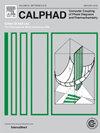fcc 镍-铁-钼合金中的相互扩散系数矩阵和原子迁移率:实验与建模
IF 1.9
3区 材料科学
Q4 CHEMISTRY, PHYSICAL
Calphad-computer Coupling of Phase Diagrams and Thermochemistry
Pub Date : 2024-11-19
DOI:10.1016/j.calphad.2024.102773
引用次数: 0
摘要
fcc 镍-铁-钼合金中精确的扩散系数对设计高质量的磁性合金具有重要意义。本研究采用 Matano-Kirkaldy 方法确定了扩散路径交叉成分的扩散系数矩阵。此外,还采用 CALTPP 程序中的数值逆方法评估了沿单个扩散耦合的整个成分剖面的扩散系数矩阵和 fcc 镍-铁-钼合金的原子迁移率。通过将预测的扩散行为与实验行为进行比较,验证了所获得原子迁移率的可靠性。此外,将目前获得的原子迁移率与热力学描述相结合,构建了 fcc 镍-铁-钼合金的扩散间隙、活化能和频率因子平面的三维图,以显示与成分和温度相关的扩散特性。目前获得的镍-铁-钼 fcc 相的扩散率和原子迁移率有望为高效镍-铁-钼磁性合金的设计做出贡献。本文章由计算机程序翻译,如有差异,请以英文原文为准。
Interdiffusivity matrices and atomic mobilities in fcc Ni–Fe–Mo alloys: Experiment and modeling
Accurate diffusivities in fcc Ni–Fe–Mo alloys are of significant importance in designing high-quality magnetic alloys. In this work, totally twelve fcc single-phase diffusion couples are assembled to determine the diffusivities of fcc Ni–Fe–Mo alloys at 1373, 1423 and 1437 K. The diffusivity matrices at the intersection compositions of diffusion paths are determined by the Matano-Kirkaldy method. In addition, the diffusivity matrices along the whole composition profiles of individual diffusion couple and the atomic mobilities of fcc Ni–Fe–Mo alloys are evaluated by the numerical inverse approach incorporated in CALTPP program. The reliability of the obtained atomic mobilities is verified by comparing the predicted diffusion behaviors with the experimental ones. Furthermore, applying the presently obtained atomic mobilities in combination with thermodynamic descriptions, the three-dimensional maps of interdiffusivites, activation energy and frequency-factor planes of fcc Ni–Fe–Mo alloys are constructed to display the composition- and temperature-dependent diffusion properties. The presently obtained diffusivities and atomic mobilities of the Ni–Fe–Mo fcc phase are expected to contribute to high-efficiency Ni–Fe–Mo magnetic alloy design.
求助全文
通过发布文献求助,成功后即可免费获取论文全文。
去求助
来源期刊
CiteScore
4.00
自引率
16.70%
发文量
94
审稿时长
2.5 months
期刊介绍:
The design of industrial processes requires reliable thermodynamic data. CALPHAD (Computer Coupling of Phase Diagrams and Thermochemistry) aims to promote computational thermodynamics through development of models to represent thermodynamic properties for various phases which permit prediction of properties of multicomponent systems from those of binary and ternary subsystems, critical assessment of data and their incorporation into self-consistent databases, development of software to optimize and derive thermodynamic parameters and the development and use of databanks for calculations to improve understanding of various industrial and technological processes. This work is disseminated through the CALPHAD journal and its annual conference.

 求助内容:
求助内容: 应助结果提醒方式:
应助结果提醒方式:


